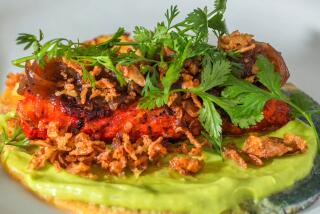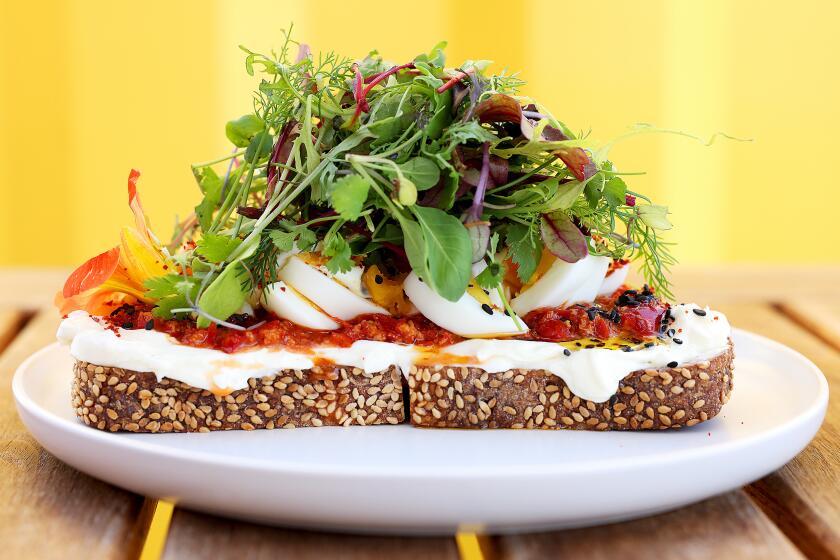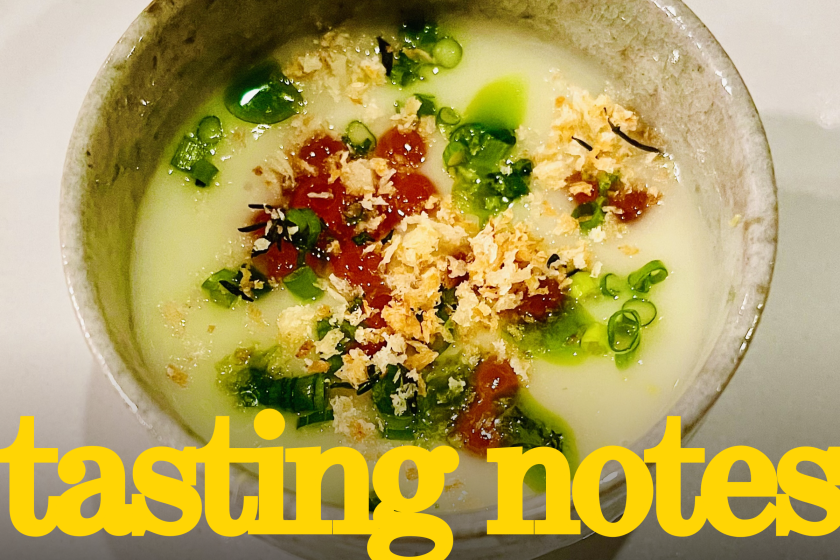Laurels for Verdicchio : This Italian White Wine Is a ‘Classico’ for Good Reason
Perhaps more than 30 years ago, during lunch with the late Louis M. Martini, that dynamic, Italian-born California wine master uttered a memorable sentence that still sticks in my mind: “We like that best to which we are accustomed.” Maybe I had wrinkled my nose while sipping a wine new to my palate. I remember, as if it were only yesterday, the intensity of his address, the glint in his kind, directly focused blue eyes.
Many years later, I had reason to remember his statement when I tasted an Italian wine that came in a funny-shaped bottle, similar to a tall vase but swollen in the middle. Even the name, with a mouthful of jumbled syllables, defied easy acceptance. And the word “Classico,” spelled out in red and gold ink, seemed an attempt to enlist respect, even if the rest of the title was unknown to me. Here it was: Fazi-Battaglia Verdicchio dei Castelli di Jesi. Beginners along the wine trail, I realized, look to traditional packaging for the most respectable bargains. Therefore, this so-called amphora design had to be something the local producers had dreamed up to sell their wine. But a little voice whispered to me: “Come on now: First, taste the product; then judge it.”
There was a whole case. I chilled a bottle, opened it, found it rather sharp and acidic, quickly assigned it to service with fish and moved on to a more familiar Chardonnay from California. The next day, remembering the words of Martini, I returned to the Verdicchio. This time, I found it still acidic, but refreshingly clean, with a long, silky body. Hmm. The third day, I went to the refrigerator with keen anticipation. That was years ago. Today this same wine in the funny bottle is among my favorite white wines from Italy, and it very well might become one of yours, too.
The literature and lore surrounding this wine reaches all the way back to Hannibal, whose Gallic mercenaries reportedly so indulged themselves that the victory fell to the defending Romans, who consequently and forever honored the wine as an ally. The lyric Italian poet-of-the-vine, Luigi Veronelli, is fond of recalling other advocates who have sung praises of this wine as “sifted gold . . . powdered topaz . . . nectar of the gods.” With all that praise, I thought, and with today’s technology, perhaps such an ancient wine deserves a fresh look.
That chance came my way recently when Michele Miglietta, a lawyer and administrator for Fazi-Battaglia, was in California on behalf of his firm (he started with them in 1957 and is now their vice-president). The name Fazi-Battaglia stands for two friends--actually brothers-in-law--who, to insure the quality of their grapes, early on began to buy vineyards, insisting upon 100% Verdicchio in golden-ripe clusters. In 1961, they started planting on 800 hillside acres at an elevation of 1,000 feet, thus assuring fine drainage. Today, they have nine separate vineyards given to hand-harvesting, soft pressing and slow, cool fermentation in stainless-steel, temperature-controlled fermenters. Select yeast strains are cultured by their own enologist.
Italian wine-savant Burton Anderson, another fan of this wine, praises the Verdicchio grape for its intrinsic virtuosity and points to Fazi-Battaglia as the pacesetter. The wine is brought to America by International Vintage Wine Co., the wine division of Heublein. Consequently, you should have no difficulty finding “that wine in the silly-shaped bottle.” The current release, 1983, sells for about $6; the handsome 1.5 liter, which makes a wonderful host present, is priced at a modest $8.50.
Early on, the two brothers-in-law, not content with the zooming success of their Verdicchio dei Castelli di Jesi, began to look around for a companion offering of red wine. In 1969, they found it in Tuscany (famous for Chianti and the legendary Brunello di Montalcino), in the Vino Nobile di Montepulciano, which they consider the king of Italian red wines. As they had done in the Jesi region, they took over a venerable winery (Fassati), tunneled into hillsides and continued their vinous revolution with Vino Nobile. Their confidence in that wine was rewarded when the august appellation controllers of Italian table wines granted their Vino Nobile de Montepulciano the coveted DOCG status. (DOCG-- Denominazione di Origine Controllatae Garantita-- means “Denomination of Origin Controlled and Guaranteed” in English and is the highest rating an Italian wine can achieve.)
This good ruby wine of Tuscany differs from both Chianti and Brunello because of its parent-grape--Prugnolo Gentile. Albeit a clonal relative of Sangiovese Grosso of Brunello, this grape brings a more profound depth of character to the wine. There is a blending with perhaps 25% Canaiolo Nero and 5% of the relatively obscure Mammolo, which contributes a violet perfume to the blend. At lunch with Miglietta, I tasted the Fassati 1979 Vino Nobile de Montepulciano (DOCG) Reserva ($11.25) and found it truly an important wine, worthy of that nobile laurel in its title. (Historically, the word nobile indicates that only “noble” grape varieties of signal ripeness are gathered for making the wine.) Fazi and Battaglia have indeed taken Fassati, a winery that was founded in 1883, to new heights of quality.
More to Read
Eat your way across L.A.
Get our weekly Tasting Notes newsletter for reviews, news and more.
You may occasionally receive promotional content from the Los Angeles Times.










